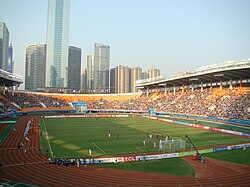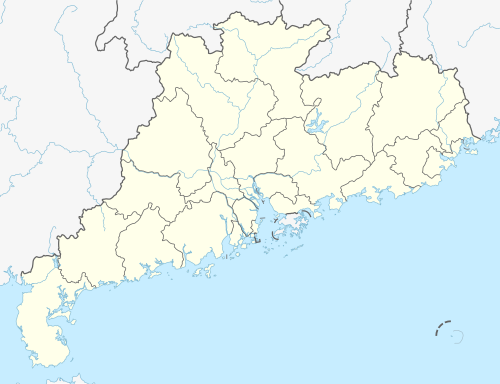Top Qs
Timeline
Chat
Perspective
1991 FIFA Women's World Cup
International football competition From Wikipedia, the free encyclopedia
Remove ads
The 1991 FIFA Women's World Cup was the first FIFA Women's World Cup, the world championship for women's national football teams. It took place in Guangdong, China from 16 to 30 November 1991. FIFA, football's international governing body selected China as host nation as Guangdong had hosted a prototype world championship three years earlier, the 1988 FIFA Women's Invitation Tournament. Matches were played in the provincial capital, Guangzhou, as well as in Foshan, Jiangmen and Zhongshan. The competition was sponsored by Mars, Incorporated, maker of M&M's candy. With FIFA still reluctant to bestow their "World Cup" brand, the tournament was officially known as the 1st FIFA World Championship for Women's Football for the M&M's Cup.[1]
It was won by the United States,[2] whose captain April Heinrichs formed a forward line dubbed the "Triple-Edged Sword" with Carin Jennings and Michelle Akers-Stahl. Jennings was named player of the tournament while Akers-Stahl's ten goals won the Golden Boot.[3] The United States defeated Norway 2–1 in the final in front of a crowd of 63,000 people at Guangzhou's Tianhe Stadium.[4] Total attendance for the tournament was 510,000, an average per match of 19,615. In the opening match at the same stadium, Norway was defeated 4–0 by hosts China. Chinese defender Ma Li scored the first goal in Women's World Cup history, while goalkeeper Zhong Honglian, also of China, posted the first official "clean sheet" in the tournament.
The 12 qualified teams were divided into three groups of four (A to C). The top two teams and the two best third-place finishers from the three groups advanced to the knockout round of eight teams. For only the first edition of the Women's World Cup, all matches lasted only 80 minutes, instead of the typical 90, and two points were awarded for a win (both of which would change in 1995).[5]
Remove ads
Venues
Remove ads
Participating teams and officials
Qualification
The 1991 Women's World Cup had twelve participating teams compete in the final tournament. Each of the six FIFA confederations had at least one representative.
Remove ads
Squads
For a list of the squads that contended for the final tournament, see 1991 FIFA Women's World Cup squads.
Match officials
Summarize
Perspective
For the first time in FIFA competition, six female officials were included. All functioned as lineswomen, except for Cláudia Vasconcelos who took charge of the third place play-off; becoming the first woman to referee a match sanctioned by FIFA.[6][7]
Remove ads
Tournament review
FIFA's technical report demonstrates that, after the tournament, players and officials were undecided whether to persist with 80-minute matches, or to change to 90 minutes in line with men's football. Opinion was also divided about the suitability of using a size five football. Some teams reported difficulty in sourcing good quality equipment in the correct size.[9]
The tournament was considered a major success in the quality of play and attendances at the games. FIFA president João Havelange wrote that:[10]
"As president of FIFA it was a special pleasure for me to watch these young ladies playing with such flair and such elegance, and according to the reports of the many media representatives present, making the game truly into a celebration ... women's football is now well and truly established."
The perceived success of the tournament was a significant factor in the subsequent inclusion of women's football in the 1996 Summer Olympics.[11] Sue Lopez reported that although attendances were very high, many tickets were complimentary. The "novelty factor" of women from foreign lands playing football also encouraged local people to attend.[12]
Remove ads
Draw
The draw for the group stage was held on 14 September 1991 at the Tianhe Stadium in Guangzhou, China. The draw was part of a televised two-hour live show, featuring songs in both Chinese and English from the female singers Zhang Qiang (Beijing), Lin Ping (Guangzhou), Jenny Tseng (Hong Kong) and Irene Yeh (Taiwan).[13]
Group stage
Group A
Group B
Source: FIFA
Group C
Ranking of third-placed teams
Source: FIFA
Rules for classification: 1) Points; 2) Goal difference; 3) Goals scored.
Rules for classification: 1) Points; 2) Goal difference; 3) Goals scored.
Remove ads
Knockout stage
Bracket
| Quarter-finals | Semi-finals | Final | ||||||||
| 24 November – Guangzhou (Tianhe) | ||||||||||
| 0 | ||||||||||
| 27 November – Guangzhou (Ying Tung) | ||||||||||
| 1 | ||||||||||
| 1 | ||||||||||
| 24 November – Jiangmen | ||||||||||
| 4 | ||||||||||
| 3 | ||||||||||
| 30 November – Guangzhou (Tianhe) | ||||||||||
| 2 | ||||||||||
| 1 | ||||||||||
| 24 November – Zhongshan | ||||||||||
| 2 | ||||||||||
| 1 | ||||||||||
| 27 November – Guangzhou (Provincial) | ||||||||||
| 2 | ||||||||||
| 2 | ||||||||||
| 24 November – Foshan | ||||||||||
| 5 | Third place play-off | |||||||||
| 7 | ||||||||||
| 29 November – Guangzhou (Provincial) | ||||||||||
| 0 | ||||||||||
| 4 | ||||||||||
| 0 | ||||||||||
Quarter-finals
Semi-finals
Third place play-off
Final
Remove ads
Awards
The following awards were given at the conclusion of the tournament:[15]
Statistics
Goalscorers
There were 99 goals scored in 26 matches, for an average of 3.81 goals per match. Michelle Akers-Stahl of the United States won the Golden Boot award for scoring ten goals.
10 goals
7 goals
6 goals
5 goals
4 goals
3 goals
2 goals
1 goal
 Elane
Elane Ma Li
Ma Li Sun Qingmei
Sun Qingmei Sun Wen
Sun Wen Wei Haiying
Wei Haiying Wu Weiying
Wu Weiying Zhou Yang
Zhou Yang Chou Tai-ying
Chou Tai-ying Lin Mei-chun
Lin Mei-chun Lisbet Kolding
Lisbet Kolding Hanne Nissen
Hanne Nissen Annette Thychosen
Annette Thychosen Gudrun Gottschlich
Gudrun Gottschlich Silvia Neid
Silvia Neid Britta Unsleber
Britta Unsleber Feriana Ferraguzzi
Feriana Ferraguzzi Rita Guarino
Rita Guarino Adele Marsiletti
Adele Marsiletti Raffaella Salmaso
Raffaella Salmaso Kim Nye
Kim Nye Birthe Hegstad
Birthe Hegstad Hege Riise
Hege Riise Susanne Hedberg
Susanne Hedberg Ingrid Johansson
Ingrid Johansson Malin Lundgren
Malin Lundgren Joy Biefeld
Joy Biefeld Julie Foudy
Julie Foudy Wendy Gebauer
Wendy Gebauer
1 own goal
 Sayuri Yamaguchi (against Sweden)
Sayuri Yamaguchi (against Sweden) Terry McCahill (against Norway)
Terry McCahill (against Norway)
Assists
4 assists
3 assists
2 assists
1 assist
 Cenira
Cenira Shieh Su-jean
Shieh Su-jean Annie Gam-Pedersen
Annie Gam-Pedersen Hanne Nissen
Hanne Nissen Irene Stelling
Irene Stelling Birgitt Austermühl
Birgitt Austermühl Gudrun Gottschlich
Gudrun Gottschlich Beate Wendt
Beate Wendt Bettina Wiegmann
Bettina Wiegmann Anna Mega
Anna Mega Monique van de Elzen
Monique van de Elzen Agnete Carlsen
Agnete Carlsen Margunn Humlestøl
Margunn Humlestøl Hege Riise
Hege Riise Heidi Støre
Heidi Støre Cathrine Zaborowski
Cathrine Zaborowski Anneli Andelén
Anneli Andelén Anette Hansson
Anette Hansson Ingrid Johansson
Ingrid Johansson Michelle Akers-Stahl
Michelle Akers-Stahl Joy Biefeld
Joy Biefeld Linda Hamilton
Linda Hamilton
Source: FIFA Technical Report[16]
Tournament ranking
Per statistical convention in football, matches decided in extra time are counted as wins and losses, while matches decided by penalty shoot-outs are counted as draws.
Remove ads
See also
References
External links
Wikiwand - on
Seamless Wikipedia browsing. On steroids.
Remove ads




